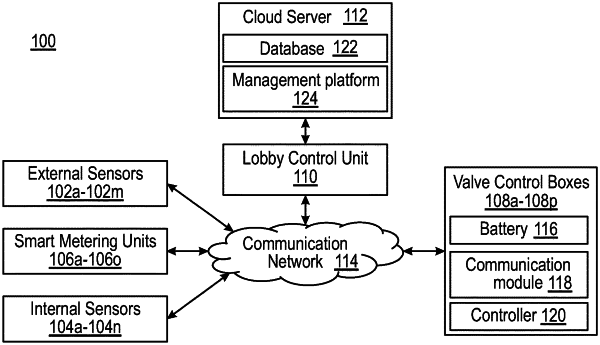| CPC F24F 11/47 (2018.01) [F24F 11/58 (2018.01); F24F 11/67 (2018.01); F24F 2110/10 (2018.01)] | 17 Claims |

|
1. A Heating, Ventilation, and Air-Conditioning (HVAC) system comprising:
a plurality of external sensors to sense data associated with one or more external variables associated with an external environment of a building;
a plurality of internal sensors configured to sense data associated with one or more internal variables from within the building;
a plurality of valve control boxes to control an operation of one or more actuator valves installed at one or more radiators and one or more air dampers of one or more virtual HVAC zones of the building; and
a Smart Metering Unit (SMU) connected to one or more of the plurality of external sensors, one or more of the plurality of internal sensors, and one or more of the plurality of valve control boxes, wherein the SMU is configured to:
receive the sensed data from one or more of the plurality of external sensors and one or more of the plurality of internal sensors;
transmit, wirelessly, the received sensed data to a cloud server over a communication network;
receive one or more rules generated by a management platform of the cloud server, wherein the one or more rules are generated by the management platform by using an Artificial Intelligence (AI) algorithm;
the AI algorithm:
detecting an occupancy status of a given zone of the building based on motion sensor data;
detecting an open window of the given zone based on the sensed data;
training an AI model to predict an occupancy status of the given zone based on historic motion sensor data;
training the AI model to predict an amount time necessary to change the temperature of the given zone by a predetermined amount; and
training the AI model to predict times at which a side of the building is exposed to sunlight;
generating the one or more rules to control a temperature of the given zone based on the occupancy status, the detected open window, the predicted occupancy status, the predicted amount time necessary to change the temperature, and the predicted times at which a side of the building is exposed to sunlight; and
transmit the received one or more rules to the one or more of the plurality of valve control boxes to control the operation of the one or more actuator valves installed at the one or more radiators and the one or more air dampers to control heating and cooling of the one or more virtual HVAC zones of the building;
wherein the SMU is configured to monitor an amount of time taken by the valve control boxes to actuate the one or more valves and a cost of running the one or more valves per unit of time, and determine a cost of running each of the one or more valves against a total energy consumption of the HVAC system; and
wherein the SMU is further configured to determine an energy saving of the building based on the cost of running each of the one or more valves against the total energy consumption of the HVAC system.
|